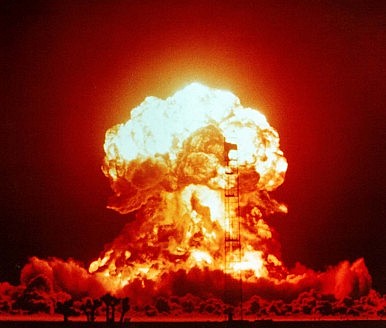
by Rabia Javed 19 March 2019
The atomic bomb revolutionized modern warfare not by enabling the mass slaughter of civilians but by vastly increasing its efficiency—the ease with which densely populated cities could be annihilated. Many of the crucial details are top secret, and the mundane terms used in official discussions tend to hide the apocalyptic consequences at stake.
A new nuclear arms race has begun to match each other’s overkill capacity. The new nuclear arms race does not center’s on the number of weapons but it depends on the qualitative refinement of nuclear capabilities and their increasing deadlines.
Recent nuclear missile tests by India show that India is blatantly flaunting its nuclear power vertically, posturing as tough and responsible “protectors” while in reality it puts the world at large risk. This attitude from Indian side of continuous arming herself up is alarming for the region to a greater extent.
When we shuffle the pages of history, it appears that India – a champion of nuclear disarmament during much of the Cold War – reversed its position in the 1990s. With the passage of time their double standards have led them built their nuclear arsenal at a faster pace. Former Indian governments’ position was – that nuclear weapons are unacceptable weapons of mass destruction designed to slaughter civilians – no longer holds sway in New Delhi.
Perhaps equally distressing is the behavior of the international community that up till now failed to loudly condemn India for their continuous missile and nuclear development program.After critically analyzing the current and past events one can come to know that the world powers and so called pundits of nuclear disarmament failed to criticize the actions of India to a greater extent. In contraststates have responded with deafening silence or worse: a renewed focus on rearmament. These moves by India creates incentives – or perhaps a pretext – for other states to develop similar arms.
India even after acquiring nuclear weapons is yet not internationally recognized as a nuclear-weapons state under the terms of the Non-Proliferation Treaty (NPT). India detonated its first plutonium device, which it called a “peaceful nuclear explosive” in 1974. Again in 1998, it tested its first nuclear weapons under the ambit of peaceful nuclear explosion. Since India conducted its tests in 1998, India has undergone impressive developments for both its nuclear program and missile arsenal.
It is necessary to expose these myths and highlight the existing realities. India sees its nuclear weapons capacity to be an integral part of its vision as a great power, and its nuclear program is important for both its prestige and security doctrine. Currently, India is increasingly developing its nuclear capabilities that could potentially support the development of thermonuclear weapons, raising the stakes in an arms race with China and Pakistan. These revelations highlights that India is expanding its weapons and enriching uranium in addition to plutonium. India’s nuclear deal with the United States (US) and the granting of a waiver for importing nuclear materials (which must be for non-military purposes) allows it to use more of its indigenously produced nuclear material for weapons. India is has also heavily invested in research on using thorium in reactors (or even potentially weapons), which will free up its other nuclear material for weapons. India hopes to soon operate thorium reactors.
Meanwhile, the US Foreign Policy magazine in 2012 reported that India had built two top-secret facilities at Challakere, Karnataka. These sites would be the South Asia’s largest military-run complex of nuclear centrifuges, atomic-research laboratories and weapons and aircraft-testing facilities. The research further stated that further says that another of the project’s aim is “to give India an extra stockpile of enriched uranium fuel that could be used in new hydrogen bombs, also known as thermonuclear weapons, substantially increasing the explosive force of those in its existing nuclear arsenal. Despite these activities, the US and its Western allies are busy selling nuclear reactors and material to India for commercial gains and advocating its entry into the Nuclear Suppliers Group.
None of the South Asian states believe the common story of India’s nuclear program—that India developed nuclear weapons in response to China’s or Pakistan’s nuclear program. Nuclear test of India was an extension of India’s aspiration to become a great power. It is beyond doubt that as long as the international community focuses its efforts on “irresponsible” nuclear behavior, such as proliferation and nuclear testing, global nuclear disarmament will remain difficult to achieve.

Good To Read